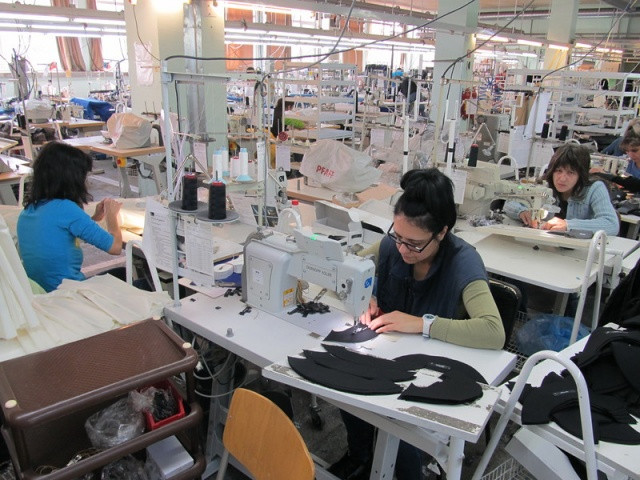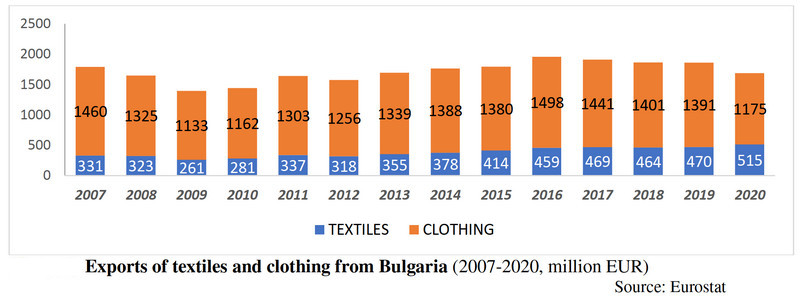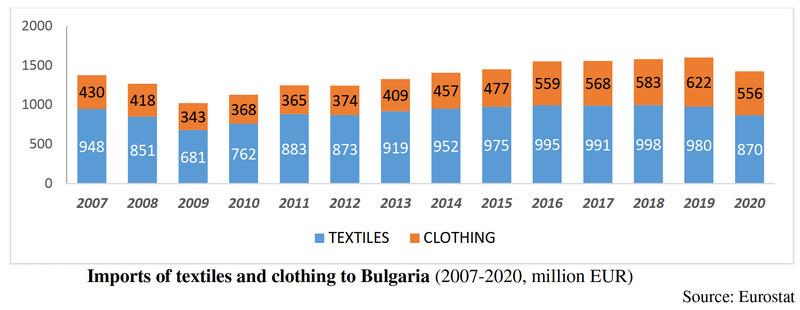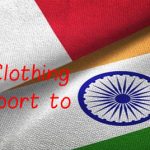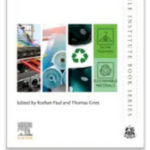The Textile & Clothing industry is a typical low-technology (just one product group – SITC code 653 – Man-made woven fabrics is classified as medium-tech), footloose industry that is dependent on low-wage levels which makes
low-cost countries attractive manufacturing locations. With joining the EU, continuous economic development and raising living standards the competitive performance of Bulgaria and Romania in the sector has been declining.
In the year of EU accession 718 textile and 4911 apparel (predominantly micro- and small) enterprises operated in Bulgaria, while in 2018 their number has shrank to 692 and 4379, respectively. The same trend of companies leaving the market throughout the period is observed in Romania. In 2007 the industry provided employment to over 168 thousand people in Bulgaria (20.4 thousand in textiles and 148 thousand in apparel production) accounting for over quarter of the manufacturing jobs in the country. In 2018 less than 100 thousand people work in the T&C industry (12.8 thousand in the textile subsector and 86.8 thousand in the apparel subsector) representing less than 18% in the manufacturing employment. In 12 years the T&C industry has lost almost 69 thousand jobs in Bulgaria and over 128 thousand in Romania, with a drop in employment of 69% and 44% respectively.
The production of textiles in Bulgaria has decreased over 2007-2018 and accordingly the subsector diminished its share in the national manufacturing production from 2.4% to 1.5%. While the value of apparel production increased, the subsector has also lost weight in the country’s production, signifying a declining inter-sector competitiveness. This is also confirmed when looking at the data about the investments in the sector. In the apparel subsector they stagnated at a comparatively low level while in the textile subsector they have significantly declined – from 3.6 thousand euro per person in 2007 to 2.5 thousand euro per person in 2018.
Another blow to the industry was struck in 2020 by the COVID-19 pandemic. The unprecedented crisis hit the industry from two sides. First, the closure of the two main materials suppliers – China and Italy disrupted the global supply chains and the production capacity of enterprises. The rising prices of raw materials and transportation delays further contributed to the difficult situation of the sector. Next, it is the low consumer demand of goods that are non-essential that led to cancelled and reduced orders. Strict social distancing norms (restrictions on business meetings and live events), working from home, rising unemployment and lost incomes do not encourage the purchase of new clothes especially suits and dresses in the high prices segment. On the other hand, the pandemic stimulated the demand for pyjamas and tracksuits, but these are niche goods and it is not possible for the whole industry to rely on their production only.
Exports
Altogether the pandemic has resulted in a 9.2% y-o-y decline in the Bulgarian T&C exports in 2020. In fact, the exports of textiles have increased by 9.7% as certain Bulgarian SMEs were among the first to switch to the production of protective masks meeting the needs of the response to the health crisis. However, Bulgaria is largely specialized in the production of apparel. Therefore, the slump in the consumer demand for clothing and accordingly the drop in its exports (by 15.5%) could not be compensated by the increased demand for personal protective equipment.
Imports
The imports of T&C to Bulgaria largely followed a similar trend as the exports. The major difference is that textiles dominate in imports whereas clothing dominates Bulgarian exports. The COVID-19 pandemic has resulted in a sharp decline of the imports of both clothing and textiles and in 2020 the drop was 11%. The higher decrease in imports than in exports contributed to maintaining a positive trade balance in the industry which is characteristic for Bulgaria throughout the whole analysed period.
Another aspect of competitiveness worth exploring is related to the quality of the exported product, commonly measured by Export unit value (ExUV). The higher quality allows a higher price without losing the market, hence is a necessary precondition for producers in countries with rising production costs to stay competitive. The ExUV of textile and clothing products from Bulgaria have increased substantially from 2007 to 2020, but in comparison with Romania there is a significant gap.
Value-added Products
Within the clothing subsector Bulgaria has been predominantly specialized in high-value garments with their share hovering around 75%. The COVID-19 pandemic in 2020 resulted in a significant drop in their share to 70.8% as these were the products most negatively affected by the ensuing economic crisis. The textile subsector which has been dominated by lower value products has further downgraded because of the pandemic. While in 2007 the share of high-value textile products in Bulgaria was 24.4% in 2020 it dropped to 15.5%.
The T&C industry has always been an important sector in Bulgaria’s economy, playing a significant role
in the social and economic development of many regions across the country. It provides jobs to almost 100 thousand people and is a key exporting industry accounting for over 6% of the national merchandise export in 2020. Furthermore, it consistently records positive trade balance bringing in foreign exchange in the country. In 2020 the positive trade balance in the industry had a value of about 264 million euro.
The COVID-19 pandemic has hit the industry very hard further catalysing the trend. This applies mainly to the garment producers which have faced a slump in the demand of their products, shrinking turnovers and serious bankruptcy risks. Flexible textile producers which managed to shift their production lines to personal protective equipment have managed to weather the storm much more smoothly.
In a post-pandemic world, the T&C industry in Bulgaria and Romania faces several challenges and the way it responds will determine the development prospects of the sector. First and foremost, it is the strong environmental imprint of the industry that puts it under increasing global pressure for stricter environmental compliance. Reducing the use of resources and increasing circularity of the production processes will be crucial in the forthcoming green transition of the industry. Next, the industry confronts shortage of workers due to mass emigration and ageing population in both countries. Digitising business operations and reskilling and upskilling of the workforce is necessary to respond to this challenge. Finally, it is increasingly less possible to withstand the competition with the production of simple products. Investing in development of new materials and product innovation and adding higher value is a must to stay competitive on the international market.
List Of Bulgarian Textile and Clothing Manufacturers, Importers and Exporters is given below:
